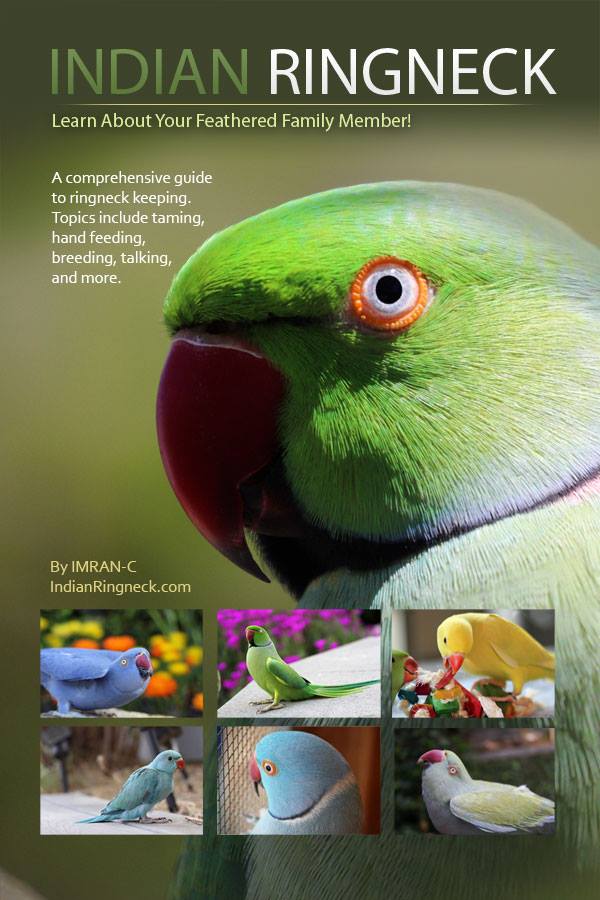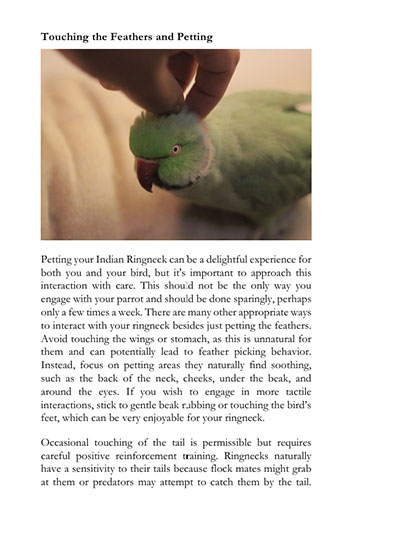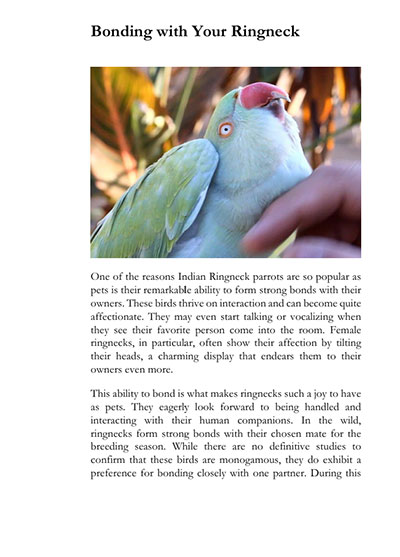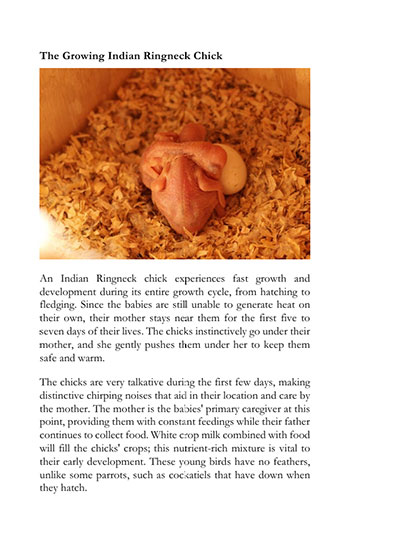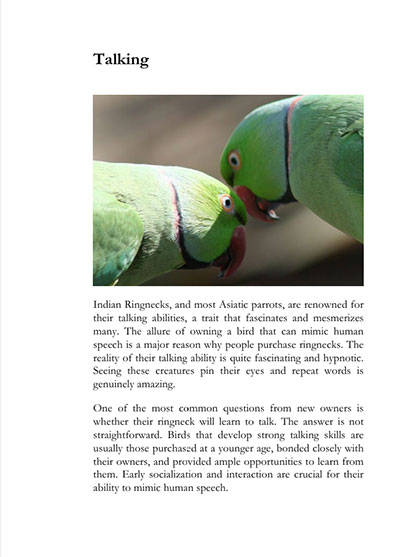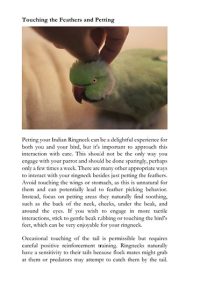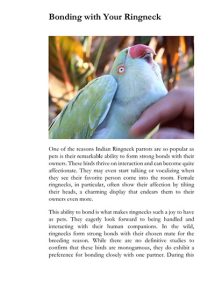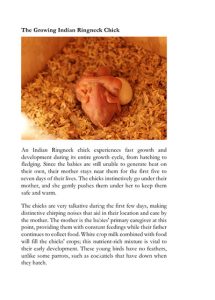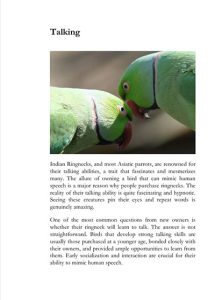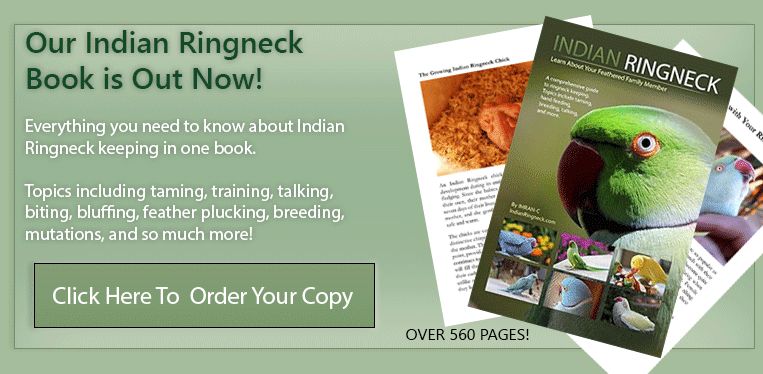
The book is now available on Kindle
Indian Ringneck: Learn About Your Feathered Family Member is a 567-page comprehensive guide, richly illustrated with colorful photos that bring the vibrant world of Indian Ringneck parakeets to life. This detailed book not only covers the history and various species of ringnecks but also provides in-depth guidance on all aspects of their care.
From deciding on ownership to creating ideal housing and aviary setups, the book offers practical advice for both new and seasoned bird enthusiasts. Readers will find an introduction to the numerous mutations, showcasing the stunning variety within the species. The breeding section is thorough, covering everything from courtship to raising juveniles, with clear instructions on hand-feeding.
Behavioral topics are explored in detail, providing solutions for common challenges like biting, screaming, and feather plucking. Training and socialization tips help owners cultivate a rewarding relationship with their birds. The book also delves into the ringnecks’ unique behaviors, such as their ability to talk, and emphasizes the importance of a balanced diet and proper nutrition.
Health care is another key focus, equipping readers with the knowledge to maintain their birds’ well-being and recognize signs of illness. The vibrant photos throughout the book enhance the learning experience, making this a visually engaging and informative resource for anyone dedicated to understanding and caring for their feathered family members.
Sample Pages
Why Indian Ringneck: Learn About Your Feathered Family Member is Essential for Prospective Owners
“Indian Ringneck: Learn About Your Feathered Family Member” is more than just a guide; it’s a comprehensive resource designed to equip both new and seasoned parrot enthusiasts with the knowledge they need to care for and understand these captivating birds. Indian Ringnecks are known for their intelligence, vibrant personalities, and unique needs, making it essential for prospective owners to have a thorough understanding before bringing one into their home.
History and Characteristics
The book delves deeply into the history and origins of Indian Ringnecks, providing context on their natural behaviors and traits. Understanding the term “Ringneck” and learning about other related species such as African Ringnecks, Alexandrine Parakeets, and Plum-headed Parakeets helps prospective owners appreciate the diversity within the parrot family and make informed decisions about which bird might best fit their lifestyle.
Comprehensive Care Guidance
Bringing home an Indian Ringneck is a significant commitment, and the book offers detailed guidance on this process. Topics such as whether Ringnecks are suitable first birds, addressing common stereotypes, and dealing with neophobia (fear of new things) are covered to prepare owners for the challenges they may face. The book also discusses the considerations of adding a second Ringneck, which is crucial for understanding social dynamics and ensuring the well-being of the birds.
Safety and Health
Safety is paramount for any pet, and the book provides extensive information on keeping a Ringneck safe within a home environment. Detailed sections on household hazards, including electronics, open stoves, windows, ceiling fans, and toxic plants, offer practical advice on creating a safe space. Additionally, guidance on proper wing clipping, beak maintenance, nail clipping, and molting ensures that owners can maintain their Ringneck’s physical health.
Behavioral Insights and Socialization
Indian Ringnecks are known for their complex behaviors, and the book dedicates sections to understanding and managing these. Whether it’s distinguishing between bluffing and biting, socializing a juvenile, or dealing with behavioral issues, the insights provided help owners foster a positive and enriching environment. The inclusion of consultation with behavior specialists further underscores the importance of expert guidance in nurturing a well-adjusted bird.
Feral Populations
The book also explores the global presence of Rose-ringed Parakeets, highlighting their adaptation in various urban settings and the ecological impact of feral populations. This knowledge is crucial for understanding the broader context of Indian Ringnecks in the wild and the importance of conservation efforts.
Regulatory Awareness
With varying restrictions on Rose-ringed Parakeets across different countries, the book’s section on regulations is indispensable. It helps prospective owners navigate the legal landscape, ensuring compliance with local laws and understanding the significance of these regulations in protecting both the species and native ecosystems.
Informed Decision-Making
Finally, the book emphasizes the importance of thorough research before purchasing an Indian Ringneck. It encourages readers to connect with other owners, engage in hands-on experiences, and consider the long-term commitment involved in caring for these birds. Topics like breeding season, hand-fed babies, and the nuances of rehomed parrots provide a well-rounded perspective that aids in making an informed decision.
In conclusion, “Indian Ringneck: Learn About Your Feathered Family Member” is an essential guide for anyone considering bringing an Indian Ringneck into their home. Its comprehensive coverage of history, care, safety, behavior, and regulations ensures that prospective owners are well-prepared to provide a loving and knowledgeable home for their feathered family member.
